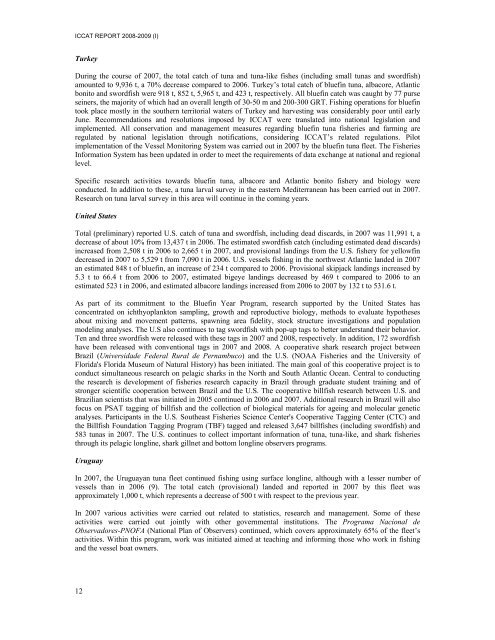REPORT OF THE STANDING COMMITTEE ON RESEARCH ... - Iccat
REPORT OF THE STANDING COMMITTEE ON RESEARCH ... - Iccat
REPORT OF THE STANDING COMMITTEE ON RESEARCH ... - Iccat
Create successful ePaper yourself
Turn your PDF publications into a flip-book with our unique Google optimized e-Paper software.
ICCAT <strong>REPORT</strong> 2008-2009 (I)TurkeyDuring the course of 2007, the total catch of tuna and tuna-like fishes (including small tunas and swordfish)amounted to 9,936 t, a 70% decrease compared to 2006. Turkey’s total catch of bluefin tuna, albacore, Atlanticbonito and swordfish were 918 t, 852 t, 5,965 t, and 423 t, respectively. All bluefin catch was caught by 77 purseseiners, the majority of which had an overall length of 30-50 m and 200-300 GRT. Fishing operations for bluefintook place mostly in the southern territorial waters of Turkey and harvesting was considerably poor until earlyJune. Recommendations and resolutions imposed by ICCAT were translated into national legislation andimplemented. All conservation and management measures regarding bluefin tuna fisheries and farming areregulated by national legislation through notifications, considering ICCAT’s related regulations. Pilotimplementation of the Vessel Monitoring System was carried out in 2007 by the bluefin tuna fleet. The FisheriesInformation System has been updated in order to meet the requirements of data exchange at national and regionallevel.Specific research activities towards bluefin tuna, albacore and Atlantic bonito fishery and biology wereconducted. In addition to these, a tuna larval survey in the eastern Mediterranean has been carried out in 2007.Research on tuna larval survey in this area will continue in the coming years.United StatesTotal (preliminary) reported U.S. catch of tuna and swordfish, including dead discards, in 2007 was 11,991 t, adecrease of about 10% from 13,437 t in 2006. The estimated swordfish catch (including estimated dead discards)increased from 2,508 t in 2006 to 2,665 t in 2007, and provisional landings from the U.S. fishery for yellowfindecreased in 2007 to 5,529 t from 7,090 t in 2006. U.S. vessels fishing in the northwest Atlantic landed in 2007an estimated 848 t of bluefin, an increase of 234 t compared to 2006. Provisional skipjack landings increased by5.3 t to 66.4 t from 2006 to 2007, estimated bigeye landings decreased by 469 t compared to 2006 to anestimated 523 t in 2006, and estimated albacore landings increased from 2006 to 2007 by 132 t to 531.6 t.As part of its commitment to the Bluefin Year Program, research supported by the United States hasconcentrated on ichthyoplankton sampling, growth and reproductive biology, methods to evaluate hypothesesabout mixing and movement patterns, spawning area fidelity, stock structure investigations and populationmodeling analyses. The U.S also continues to tag swordfish with pop-up tags to better understand their behavior.Ten and three swordfish were released with these tags in 2007 and 2008, respectively. In addition, 172 swordfishhave been released with conventional tags in 2007 and 2008. A cooperative shark research project betweenBrazil (Universidade Federal Rural de Pernambuco) and the U.S. (NOAA Fisheries and the University ofFlorida's Florida Museum of Natural History) has been initiated. The main goal of this cooperative project is toconduct simultaneous research on pelagic sharks in the North and South Atlantic Ocean. Central to conductingthe research is development of fisheries research capacity in Brazil through graduate student training and ofstronger scientific cooperation between Brazil and the U.S. The cooperative billfish research between U.S. andBrazilian scientists that was initiated in 2005 continued in 2006 and 2007. Additional research in Brazil will alsofocus on PSAT tagging of billfish and the collection of biological materials for ageing and molecular geneticanalyses. Participants in the U.S. Southeast Fisheries Science Center's Cooperative Tagging Center (CTC) andthe Billfish Foundation Tagging Program (TBF) tagged and released 3,647 billfishes (including swordfish) and583 tunas in 2007. The U.S. continues to collect important information of tuna, tuna-like, and shark fisheriesthrough its pelagic longline, shark gillnet and bottom longline observers programs.UruguayIn 2007, the Uruguayan tuna fleet continued fishing using surface longline, although with a lesser number ofvessels than in 2006 (9). The total catch (provisional) landed and reported in 2007 by this fleet wasapproximately 1,000 t, which represents a decrease of 500 t with respect to the previous year.In 2007 various activities were carried out related to statistics, research and management. Some of theseactivities were carried out jointly with other governmental institutions. The Programa Nacional deObservadores-PN<strong>OF</strong>A (National Plan of Observers) continued, which covers approximately 65% of the fleet’sactivities. Within this program, work was initiated aimed at teaching and informing those who work in fishingand the vessel boat owners.12
















